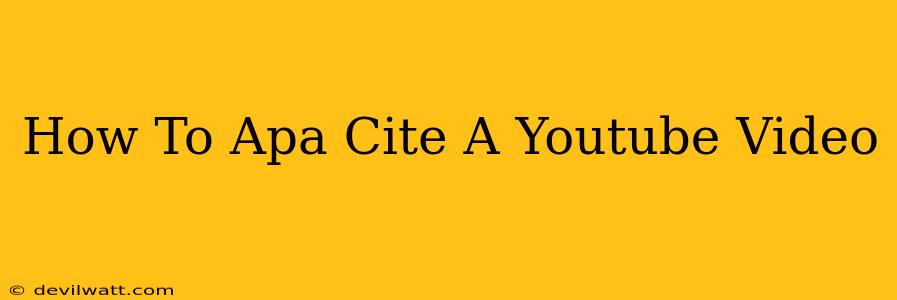YouTube has become a vast repository of information, from educational lectures to insightful documentaries. But when you use YouTube videos in your academic work, proper citation is crucial. This guide provides a clear and comprehensive explanation of how to APA cite a YouTube video, ensuring you avoid plagiarism and maintain academic integrity.
Understanding APA Citation Basics
Before diving into YouTube video citations, let's quickly review the core principles of APA style. APA (American Psychological Association) style emphasizes brevity and clarity, prioritizing the author, date, and source. The goal is to provide enough information for readers to easily locate the source material.
Key Elements of a YouTube Video APA Citation
When citing a YouTube video in APA style, you need several key pieces of information. Missing even one can significantly weaken your citation and potentially lead to accusations of plagiarism. These essential elements include:
- Author: This is the creator of the video, usually the YouTube channel name or the individual's name. If the creator is unknown, use "Anonymous" in place of the author's name.
- Year: The year the video was uploaded. If the year is unavailable, use "n.d." (no date).
- Title: The title of the video, italicized.
- Retrieved From: The URL of the YouTube video.
APA Citation Example: YouTube Video
Let's illustrate with an example. Imagine you want to cite a YouTube video titled "The Impact of Social Media on Teenagers" uploaded by the channel "Psychology Explained" on January 15, 2024. The citation would look like this:
Psychology Explained. (2024, January 15). The Impact of Social Media on Teenagers [Video]. YouTube. https://www.youtube.com/watch?v=[Video ID]
Remember: Replace [Video ID] with the actual alphanumeric ID found in the YouTube URL. You can usually find it after "v=" in the URL.
Handling Multiple Authors or Unclear Information
-
Multiple Authors: If the video has multiple creators, list them in the order they appear on the YouTube page, separated by commas and using an ampersand (&) before the last author.
-
Unknown Upload Date: If the upload date is missing, use "n.d." (no date) in place of the year.
-
No Author Listed: If no author is specified, use the channel name in place of the author's name. If the channel name is not readily available, and there's no author, use the video title as the first element within the reference entry.
In-Text Citations: Referencing YouTube Videos in Your Writing
When you refer to the YouTube video within the body of your paper, you'll need an in-text citation. This usually includes the author's name and year of publication. For example:
- "(Psychology Explained, 2024)"
Place the in-text citation at the end of the sentence where you mention the video, before the period.
Why Proper Citation Matters: Avoiding Plagiarism and Building Credibility
Properly citing your YouTube sources is not just about avoiding plagiarism; it's about demonstrating academic honesty and building credibility. By correctly referencing your sources, you showcase your research diligence and respect for intellectual property. Failing to do so can have severe academic consequences.
Conclusion: Mastering YouTube Video Citations in APA Style
With a little practice, mastering the art of APA citing YouTube videos becomes straightforward. By carefully gathering the necessary information and following the format outlined above, you can confidently integrate YouTube content into your academic work while maintaining the highest standards of academic integrity. Remember, accuracy and consistency are key to effective academic referencing.

